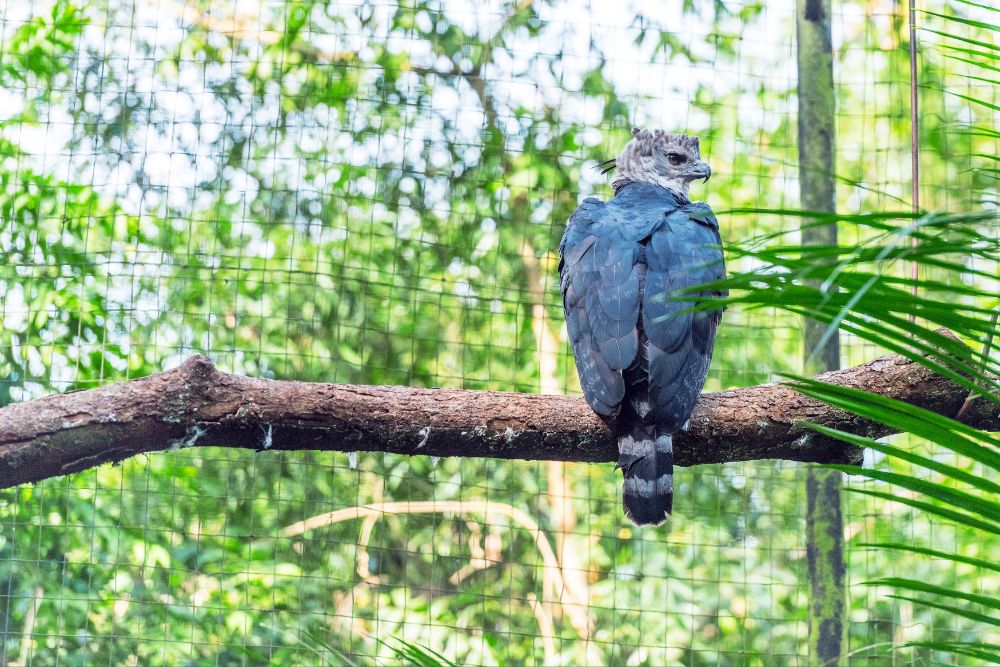Are Harpy Eagles Dangerous to Humans? Facts Revealed
- Harpy eagles are not typically aggressive towards humans, as their diet consists mainly of tree-dwelling animals.
- Encounters with harpy eagles can occur when humans enter their territory or disturb their nests.
- An aware and cautious approach can help minimize the risks associated with human-harpy eagle interactions.
Harpy eagles are one of the world’s largest and most powerful birds of prey, found primarily in the tropical rainforests of Central and South America.
Their impressive size, wingspan, and penetrating gaze have earned them a mythical reputation as formidable predators.
Naturally, the question arises: are harpy eagles dangerous to humans?
Harpy eagles are not known for actively seeking human prey, as their hunting habits are perfectly suited to their natural environment.
It is essential to understand the typical behavior and hunting patterns of harpy eagles to assess the potential risk they may pose to humans.
These majestic birds have a highly specialized diet, primarily consisting of tree-dwelling animals like sloths, monkeys, and various birds.
However, human-harpy eagle interactions can still occur, particularly when humans enter the eagles’ territory or disturb their nests.
A proactive approach to mitigating risks can ensure a harmonious coexistence between harpy eagles and humans

Are Harpy Eagles Dangerous to Humans?
Attacks On Humans
Although harpy eagles are powerful birds capable of hunting large prey, there have been very few cases of them attacking humans.
As a result, it’s generally considered that they pose a minimal threat to human safety.
However, it’s crucial to remember that wild animals can be unpredictable, and unfortunate encounters could still happen.
To reduce the risk of harm, I must maintain a respectful distance from these magnificent creatures when I venture into their territory.
Defensive Behaviors
Harpy eagles are generally known to be quite shy and elusive around humans. They tend to avoid confrontation and typically flee when they feel threatened.
I have observed that disturbance of their nests can provoke a protective response from these eagles, just like many other animals would prioritize defending their offspring.
For this reason, I need to stay clear of nesting sites during the breeding season and avoid any intrusive behavior that might trigger a defensive reaction.
By being cautious and knowledgeable about the behavior and surroundings of harpy eagles, I can safely interact with and appreciate these powerful birds without putting myself or the eagles at risk.
Mitigating Risks
As someone who is knowledgeable about harpy eagles, I believe it’s essential to discuss ways to mitigate risks for both humans and the eagles.
In this section, I will cover two key strategies: respecting their habitat and taking precautions during encounters.
Respecting Their Habitat
Harpy eagles primarily reside in tropical rainforests, and humans must respect their habitat. I suggest the following:
- Avoid entering their territories unnecessarily, as harpy eagles can be territorial and may perceive human presence as a threat.
- Stay on designated trails to minimize the chances of coming across a nesting site, which may provoke a defensive reaction from the eagles.
Precautions During Encounters
In the rare event that one encounters a harpy eagle in the wild, I recommend these practical tips to mitigate any potential harm:
- Maintain a safe distance: Give the eagle enough space to avoid feeling threatened. Observing from afar is the best approach.
- Do not feed the birds: Feeding wild animals can hurt their behavior and health and could encourage them to approach humans in the future.
- Retreat calmly: If the bird shows signs of aggression or agitation, back away slowly without making sudden movements or loud noises, as this might trigger an attack.
Following these guidelines makes it possible to remain safe and minimize negative impacts on the eagles and their habitat. Remember, a healthy respect for nature is the key to harmonious coexistence.

Harpy Eagles: An Overview
In recent years, I have observed an increasing curiosity about one of the world’s largest and most powerful birds of prey, the harpy eagle.
Found primarily in the tropical rainforests of Central and South America, I find these remarkable creatures with imposing wingspans of up to 7 feet and razor-sharp talons to be both fascinating and intimidating.
My research has shown that the harpy eagle’s primary diet consists of monkeys, sloths, and various other arboreal mammals.
These powerful birds are known for their incredible hunting abilities, which I attribute to their superb vision, hearing, and rapid flight speed.
It’s no wonder they’re considered apex predators in their habitat!
Of course, experts and enthusiasts have debated whether harpy eagles are dangerous to humans.
As a researcher, I can confidently state that while harpy eagles’ hunting abilities are indeed awe-inspiring, they do not typically directly threaten human beings.
Their preference for dense forests and tree-dwelling prey makes interactions with humans rather uncommon.
That being said, I believe it’s essential to maintain a healthy respect for these powerful predators and their environment.
I have encountered some isolated cases of harpy eagles displaying defensive behavior when their nests are disturbed.
Therefore, it’s crucial to exercise caution and follow responsible practices when in the presence of these or any other wild animals.
Human-Harpy Eagle Interactions
Habitat Overlap
In my experience, there is a potential for interaction between humans and harpy eagles, mainly due to habitat overlap.
Harpy eagles are known to inhabit tropical rainforests from southern Mexico to Argentina.
Human encroachment into these wild areas for agriculture, logging, and urban development has decreased the harpy eagle population.
As we continue to expand into their habitats, we must be aware of any potential danger that might come our way.
Nevertheless, it’s critical to note that encounters with harpy eagles are relatively rare.
Encounters in the Wild
I’ve observed that encounters between harpy eagles and humans in the wild are not a common occurrence.
These elusive raptors usually live deep in the jungle and are known for their secretive nature.
However, when someone does come across a harpy eagle in the wild, their curiosity might be piqued.
They can be intimidating due to their large size and piercing eyes, but they generally avoid confrontation with humans.
In most cases, the eagles will fly away if approached too closely. There have been very few reported cases of harpy eagles attacking humans, and none that I know of were unprovoked.

Captive Harpy Eagles
Regarding captive harpy eagles, I’ve learned that handling and interacting with them calls for extra caution.
In zoos and rehabilitation centers, these powerful birds are often managed by trained professionals who can properly approach and interact with them.
Although harpy eagles in captivity are more accustomed to human presence, it’s important to remember that they still possess their wild instincts.






